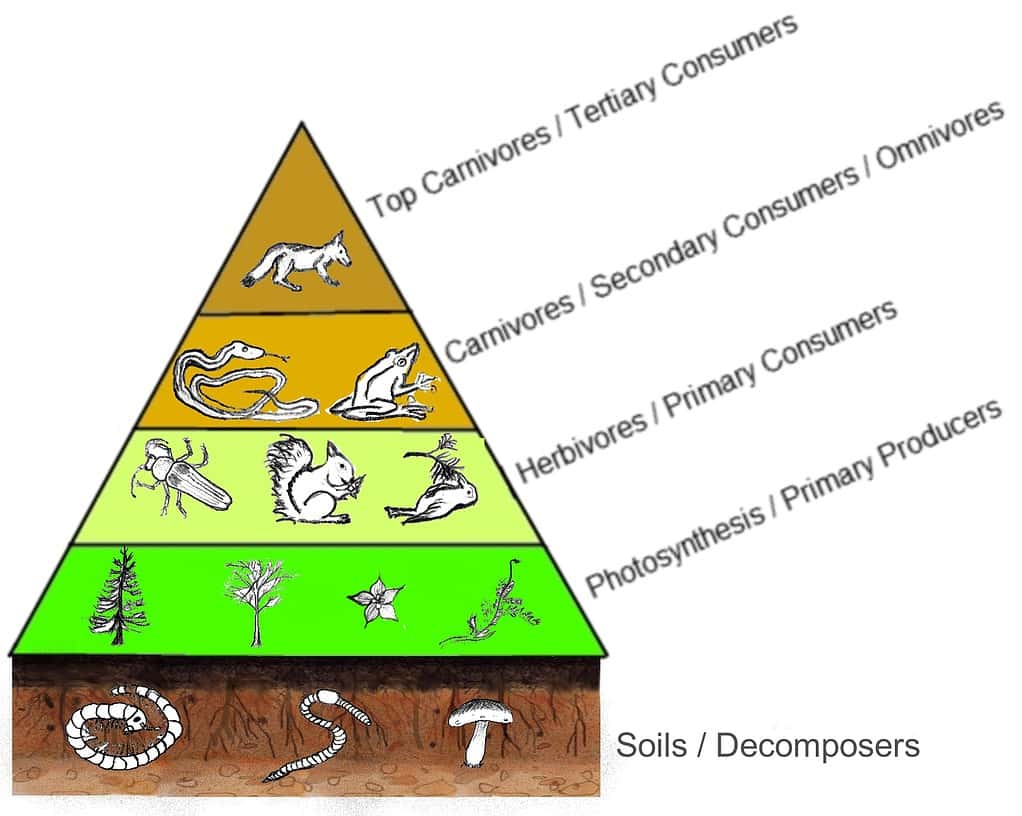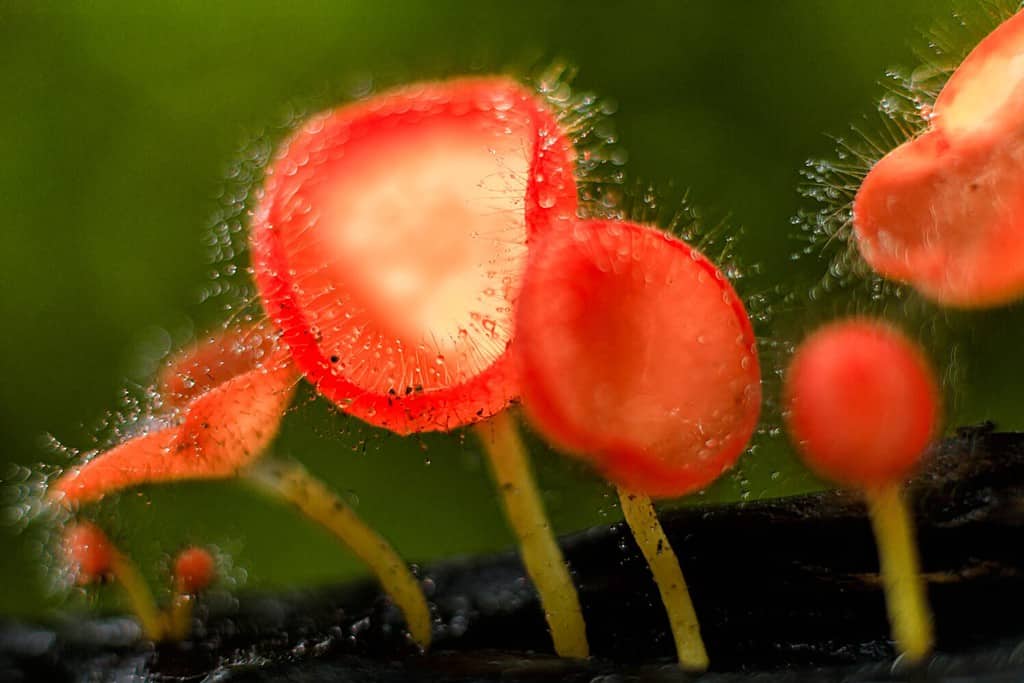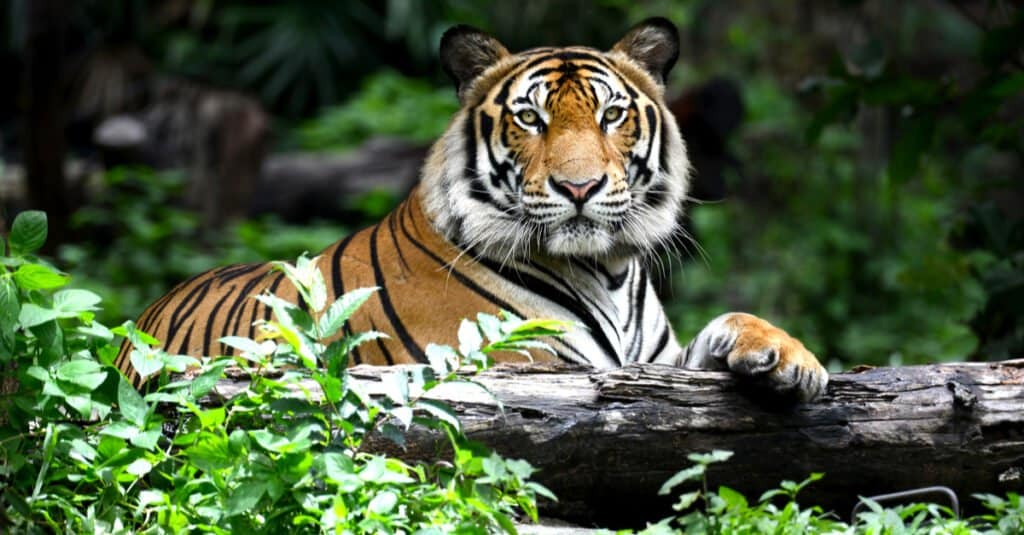Every forest in the world is full of diverse plants and animal species, which create a complex ecosystem. The food chains and web are at the heart of this ecosystem, determining which animals eat what. The organisms at the bottom are typically producers, which means they get their energy from the sun.
At the very top of this food chain are the “top predators.” These predators do not have any predators of their own. Their main struggle is finding food.
There are many forests worldwide, and each one varies in its animal occupants. For instance, a forest in North America will not contain the same animals as a Siberian forest. However, these forests contain the same basic principles and food chains. In this article, we’ll look at those similarities.
The Basics of a Forest Food Chain

Regardless of the forest they may live in, trees play a crucial role in the ecosystem, providing food and shelter for many animals.
©Wirestock Creators/Shutterstock.com
To understand the forest ecosystem, you must understand what a food chain is. Simply put, a food chain shows how energy is transferred through an ecosystem, typically by animals consuming other organisms.

A forest food chain will always include primary producers and primary consumers, no matter its location.
©Thompsma / CC BY-SA 3.0 – License
Food chains always begin with the primary producers: plants, trees, and other plant life. These make energy through photosynthesis, so they don’t rely on other organisms for food. However, they are consumed by other animals for energy.
Here’s a basic rundown of the parts of the forest food chain:
- Producers: Primary producers create the initial energy source in the forest ecosystem, typically using sunlight.
- Primary consumers: These are herbivores that consume the producers. In a forest, there are usually deer, rabbits, and some insects in this position. These creatures serve as a link between the producers and carnivores.
- Secondary consumers: These consumers are carnivores that primarily eat primary consumers. You’ll commonly find smaller carnivores like foxes, snakes, and owls taking this role in a forest. These prevent overgrazing of the plant species and keep the primary consumers in check.
- Tertiary consumers: You’ll find the top predators at the top of the food chain. These include large mammals that don’t have predators of their own. Typically, they consume both primary and secondary consumers. In a forest, these may be wolves or large birds of prey like eagles.
Decomposers also play a role in an ecosystem, but they aren’t always included in a food web. Their job is to break down the bodies and waste of animals and plants in an ecosystem, providing nutrition to the soil. In a forest, these include fungi, bacteria, and detritivores like earthworms.
Adding Complexity with the Forest Food Web

Fungi are easy to overlook, but they are an essential species in many forests.
©Chicanio/Shutterstock.com
A food chain typically is a very simplified and linear representation of who eats what in a forest. However, reality is more complex than that. Most animals eat a variety of different things. This complexity is best represented by a food web. As the name suggests, this diagram is a vast web of different relationships.
Predators, herbivores, and omnivores are all represented on this web. For instance, a bird of prey may consume a range of small mammals and insects so that it would have many connections on a food web. Herbivores typically consume lots of different plants, though some are pickier than others.
Sometimes, symbiotic relationships play a vital role in forest ecosystems, and they are often included in this food web. Mutualistic relationships, like those between mycorrhizal fungi and tree roots, enhance nutrient uptake for plants and play a key role in many forests. Parasitic relationships also exist, which involve one organism benefiting at the expense of another.
There is a lot of complexity in a forest, but here are some examples of how a food web might play out.
The Woodland Ecosystem
In the typical woodland ecosystem, trees and plants capture sunlight and convert it into energy. There are often lots of different species involved as producers. Herbivores like deer and rabbits will feed on these plants. Some feed on only certain plants, while others may consume just about anything.
Predators like foxes and hawks then consume these herbivores. Some omnivores may consume both small mammals and plants. Meanwhile, earthworms and other detritivores continue to break down fallen leaves and decaying matter, adding nutrients to the soil.
The plants take up these nutrients, and the cycle begins all over again.
Forest Canopy
In a forest canopy, things are a little bit different. In very complex forests, the animals in the canopy may not have tons of interaction with those on the ground level. Trees are usually the primary producers in the canopy. Insects and mammals feed on the trees, and then birds feed on the insects and mammals.
However, some birds may feed on tree nectar (like hummingbirds) and insects, which would make them both primary and secondary consumers.
Snakes and owls feed on the birds, and sometimes even the mammals that live high in the trees, like squirrels.
Under the Soil
As humans, we have a tendency to pay attention to what we can see. However, there is often a lot happening under the soil, too. Insects may feed on the roots of plants, as well as on other insects.
Mycorrhizal fungi have a mutualistic relationship with tree roots. The fungi aid in the nutrient absorption of the tree, and they receive sugars from the tree in return.
Keystone Species in a Forest Ecosystem

In areas where they are present, wolves are often a
keypart of the ecosystem, keeping prey populations in check.
©slowmotiongli/Shutterstock.com
All species are important in a forest ecosystem. The food web shows us that. However, not all species are as influential. Some play a disproportionately influential role in the forest ecosystem. These are called “keystone species.”
These species have a significant impact on how an ecosystem functions, even if they don’t take up a huge portion of the individuals that live in that forest. Scientists often use their presence (or absence) to determine how an ecosystem is doing.
That said, keystone species have tons of different roles. Some control the population of other species, some literally shape the environment, and others provide unique resources.
Examples of Keystone Species in Forests
Wolves are a classic example of a keystone species in forests where they are located. For instance, Yellowstone National Park recently reintroduced wolves after they had been extinct from the area for over 100 years. Research from the park has shown that the reintroduction of this species has led to an increased biodiversity of plants and an increased population for many species, including birds of prey, pronghorn, and trout.
Wolves performed this function by controlling the population of herbivores like elk, which previously had no predators in the region. Therefore, plants were able to regenerate, leading to a whole cascade of effects.
Beavers are also considered a keystone species. These occur in many riparian forests, where they create wetlands through dam building. Many other species rely on these ponds and wetlands to survive. Therefore, if the beavers disappeared, it would have a huge ripple effect.
Woodpeckers are a commonly overlooked keystone species, and they play a similar role as a beaver. Many people know that woodpeckers create holes in trees for their nests. However, many other birds use abandoned and old woodpecker holes for their own nests. Without woodpeckers, many other species of bird would have issues with reproduction.
Fungi also play a key role in most forests. Many tree species have a mutually beneficial relationship with fungi and would suffer negative effects if the fungi suddenly disappeared.
Who’s On Top of the Forest Food Chain?

Bengal tigers are apex predators in Indian forests, where they still exist. However, they are critically endangered.
©dangdumrong/Shutterstock.com
Not every forest is the same. Therefore, the top predator will differ from area to area. In some forests, there may not even technically “be” a top predator, especially in areas that have seen larger predators go extinct.
For instance, wolves were once the top predator of many North American ecosystems. However, they have since gone extinct from many forests across the continent, largely due to human intervention.
These top predators are typically called “apex” predators. They’re dominant carnivores within an ecosystem and typically have no natural predators of their own. They also have a huge role in the forest, as they may be one of the few predators keeping some larger herbivores in check. Many are keystone species.
Examples of Apex Predators in Forest Ecosystems
As we’ve already discussed, grey wolves are a relatively common apex predator in forests where they are located. Areas that have seen an extinction of wolves in the last few hundred years may actually be missing an apex predator.
Cougars are a relatively common apex predator in forested regions of the Americas. They play a similar role to the wolf, though they may have less of a population effect.
In the dense forests of India and Bangladesh, Bengal tigers are the top predators. They’re important for the overall health of the forests and are considered a keystone species.
Harpy eagles are the apex predators in some forests, especially in the canopy of the forest. They often consume many birds and even larger mammals, like monkeys. In coniferous and mixed forests, goshawks are often the apex predator.
Human Impact on Forest Food Chains and Webs
Currently, one of the biggest threats to forest food chains is deforestation and habitat destruction, which are undertaken by humans. The conversion of forests into agricultural land, suburbs, and logging operations can destroy pieces of the forest food webs, disrupting the whole ecosystem.
Deforestation removes the habitat for many species, and it alters the availability of resources within the food chain. When whole forests are cleared, all animals within the food chain are directly impacted.
Humans also introduce invasive species into the forest ecosystem, which can disrupt the natural balance of the food chain and web. Invasive species often outcompete native organisms due to their lack of natural predators. They may also prey directly on native species, who may have not adapted to avoid them. This can reshape the whole food web, but not always for the better.
Climate change also affects forests, though it doesn’t affect all equally. Altered temperatures and rain patterns can affect the behavior of many species. For instance, some species may migrate differently, which can impact food availability and predatory behaviors.
Overhunting and overfishing are other clear problems within most forests. When consumers are overexploited, it can cause producers to overpopulate and starve consumers higher on the food chain. There may be a loss of biodiversity, and the ecosystem may become unstable.
Conservation efforts are important in reducing the effects of these human activities. While humans need space to live and food to eat, it’s important to counteract these negative effects by protecting still-standing forests.
The photo featured at the top of this post is © Piper Rastello/iStock via Getty Images
Thank you for reading! Have some feedback for us? Contact the AZ Animals editorial team.







